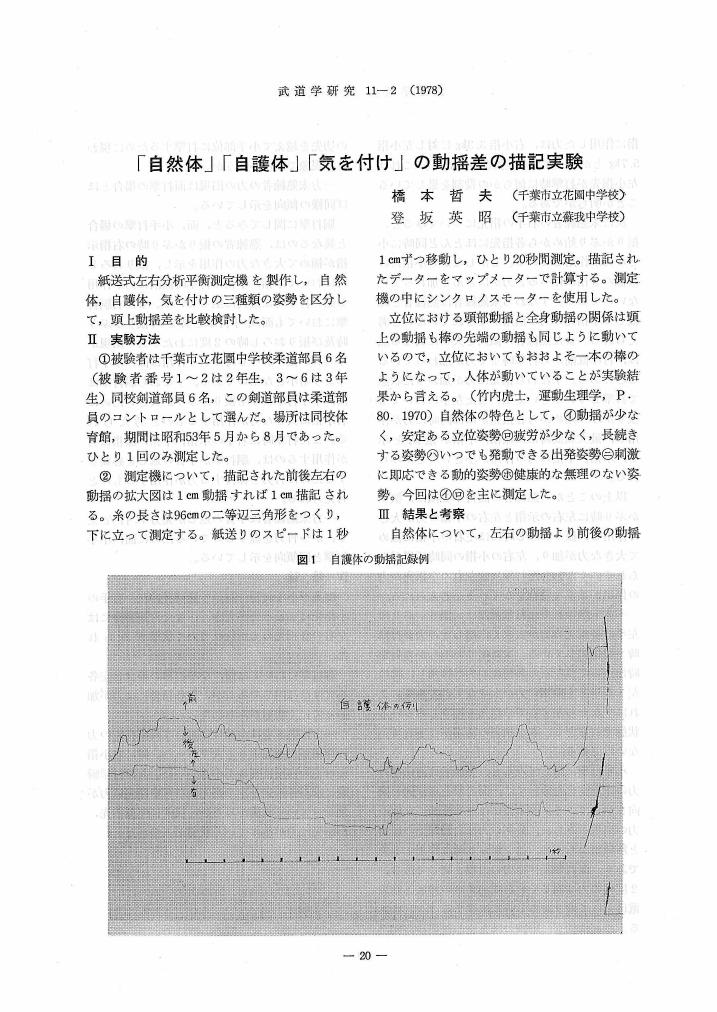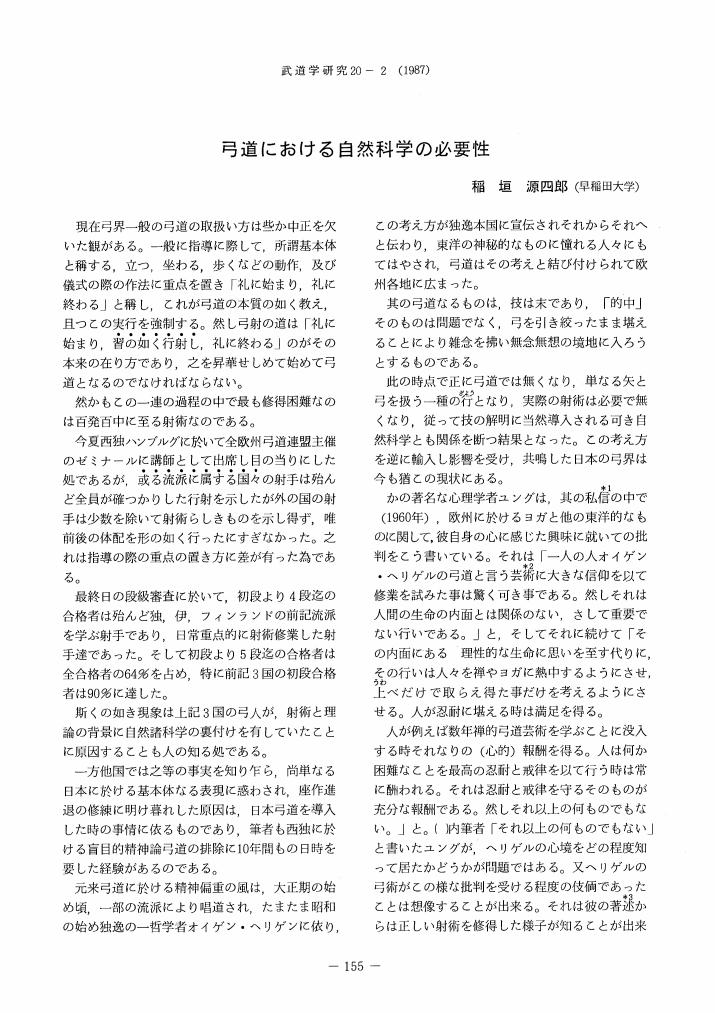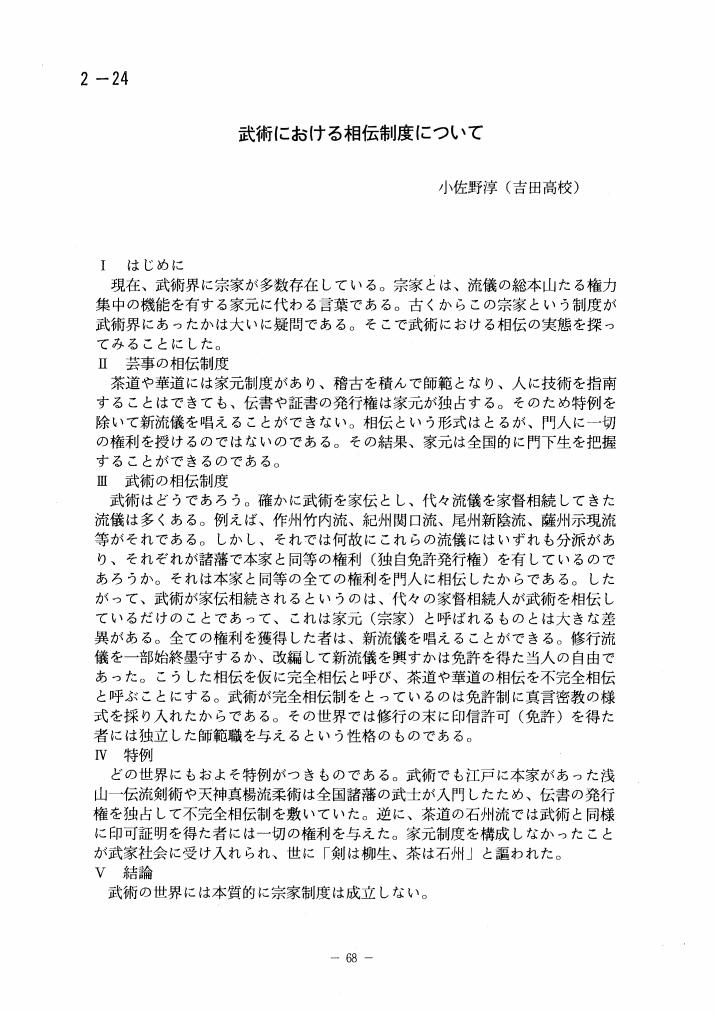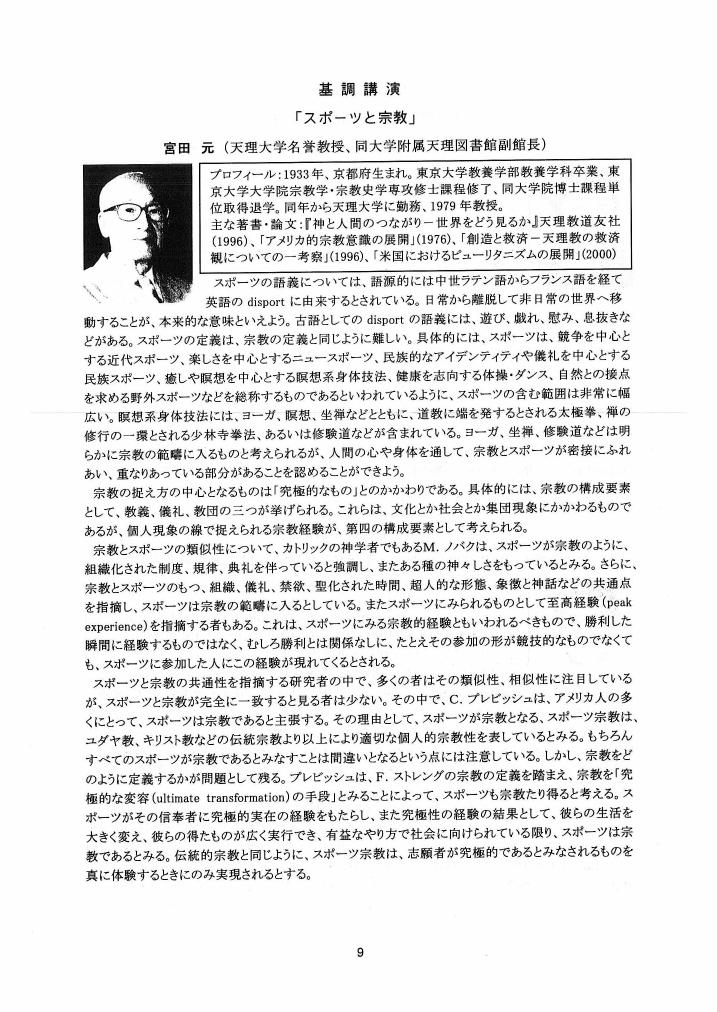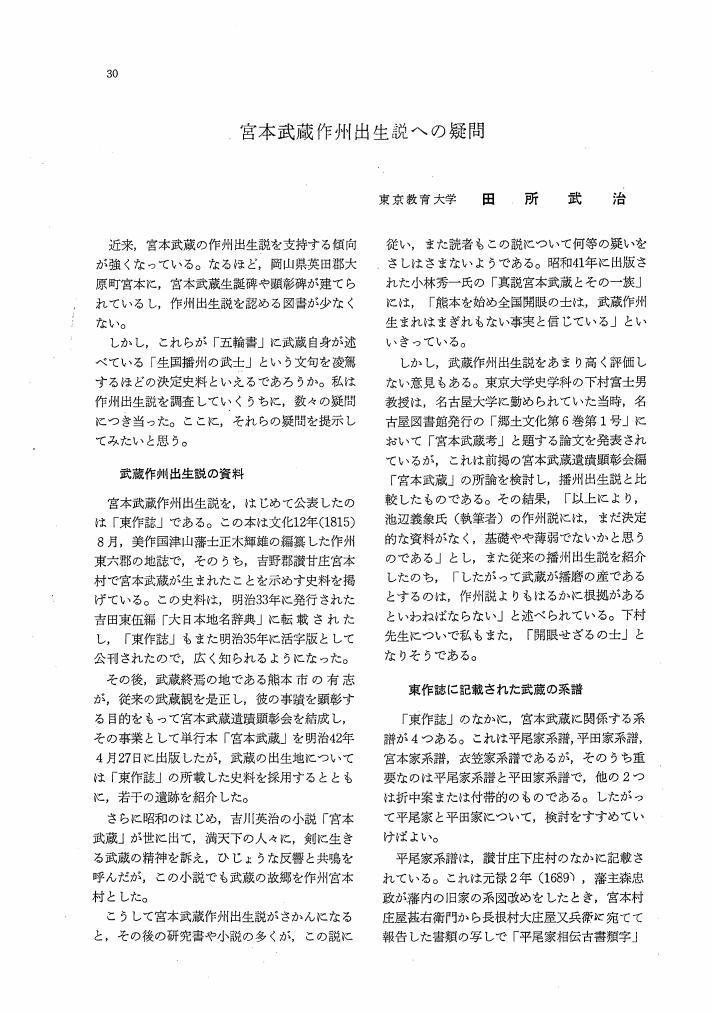3 0 0 0 OA 記紀神話にみられる弓矢について
- 著者
- 酒井 利信
- 出版者
- 日本武道学会
- 雑誌
- 武道学研究 (ISSN:02879700)
- 巻号頁・発行日
- vol.39, no.2, pp.1-15, 2006-12-31 (Released:2012-11-27)
- 参考文献数
- 92
This research aims to clarify the magical power of the bow and arrow that appear in ancient Japanese myths, including ‘Kojiki’and‘ Nihon shoki.’In my the previous study, I clarified the following in relation to the magical power of the sword that appears in ancient Japanese myths:1. the magical power of the sword2. the relationship between the sword and gods (when discussing the magical power of the sword, the sword must be sacred; this is the basis of why the sword is sacred)3. the attribute of the sword that connects the celestial world of the gods and the terrestrial world of human beings (this provides an assumption for the relationship between the sword and the gods).In this research, I investigated whether the magical power of the bow and arrow has the same structure as that of the sword, by comparing the findings of the previous study, and confirmed the following:In the myth of Arnenowakahiko, three points were found: 1. the magical power of the bow and arrow; 2. the relationship between the gods and the bow and arrow; and 3. the bow and arrow's attribute connecting between the celestial world of the gods and the terrestrial world of human beings, suggesting that the magical power of the bow and arrow has the same structure as that of the sword.· A difference from the magical power of the sword was revealed in the myth of Ninuriya.·Besides the magical power of Hekija (exorcising evil gods and demons), I found the magical power of Seisei (creating).·Although arrows themselves originally had magical power, the red color of Ninuziya represents the magical power of the blood, by which the magical power of the arrow was enhanced.·In the Ninuriya myth, I could not find the magical power of the bow, but found only the magical power of the arrow.·In the Ninuriya myth, the arrow flows down the river to the terrestrial world as the god's incarnation. This implies that the world of gods lies in the horizontal direction of the terrestrial world. However, in the Kilo myths a view of the world is expressed in a form that basically stands solid in the vertical direction. The sword and arrow of the Arnenowakahiko myth connected the celestial world of the gods to the human world on Earth. The view of the world in this vertical direction was, however, created by a new ideology, and the world view was originally horizontal. The arrow was previously understood as something that connected the comparatively old transcendence axis in the horizontal direction.
3 0 0 0 OA 「弓道ノ医学的研究」が弓道要則の解消に与えた影響に関する研究
- 著者
- 五賀 友継 松尾 牧則
- 出版者
- 日本武道学会
- 雑誌
- 武道学研究 (ISSN:02879700)
- 巻号頁・発行日
- vol.51, no.2, pp.89-99, 2018-12-28 (Released:2019-12-28)
- 参考文献数
- 54
The aim of this study was to consider the influence of “Medical Research on Kyudo”, which was conducted by surgeons in Tokyo Provisional First Army Hospital from 1939 to 1941, and which subsequently lead to the dissolution of Kyudoyosoku. This research also looks to clarify the sequence of events during that period from historical records, research contents, and the reaction of archers after the publication of “Medical Research on Kyudo”. The results can be summarized as follows:1) Kyudo was adopted at the Tokyo Provisional First Army Hospital in 1939 as part of a rehabilitation program for disabled veterans with the aim of not only restoring military spirit, but also improving body posture.2) Following the adoption of kyudo, Tokyo Provisional First Army Hospital began the “Medical Research on Kyudo” project to select the most suitable kyudo forms to aid rehabilitation. Impact on the lungs and spinal cord were examined by radiographing the chest of the archers while performing the techniques of chukan-uchiokoshi and shomen-uchiokoshi. The research concluded that skeletal deformity and chest muscle distortion could occur with the chukan-uchiokoshi style. Moreover, the research assumed that incorrect lung position could trigger the risk of pleural inflammation and several diseases with chukan-uchiokoshi, but not with shomen-uchiokoshi.3) The results of the research study were widely publicized in kyudo and budo magazines, medical academic papers, newspapers and presentations not only for the kyudo archers, but also for the general public. This widespread dissemination of information also lead to the criticism of Kyudoyosoku from outside the kyudo field. This intensified pressure on the Greater Japan Martial Virtues Association, which had adopted chukan-uchiokoshi in Kyudoyosoku, to announce a strong statement denying the research on August 22, 1941.4) In our research, we could not confirm any other cases where the Greater Japan Martial Virtues Association got into such a situation as this to give a statement against criticism of kyudo’s essential rule. Therefore, it is conceivable that “Medical Research on Kyudo” gave validity or medical justification to criticize Kyudoyosoku. Taken together, the overall criticism from kyudo archers, budo martial artists, doctors, and society in general, and specifically the results from the “Medical Research on Kyudo” that indicated harm to the human body, was one of the main factors that lead to the elimination of the kyudo rationale, or the dissolution of Kyudoyosoku.
3 0 0 0 OA 弓道選手の運動障害について
3 0 0 0 OA 柳生新陰流源流考
- 著者
- 岡田 一男
- 出版者
- 日本武道学会
- 雑誌
- 武道学研究 (ISSN:02879700)
- 巻号頁・発行日
- vol.10, no.3, pp.14-20, 1978-03-05 (Released:2012-11-27)
- 参考文献数
- 11
Mune-yoshi Yagiyu got acquainted with Hide-tsuna Kami-izumi in 1563 (A. D.). At that time, Mune-yoshi was thirty-five years old and he was commonly acknowledged that he was one of the greatest swordsmen ever known. But, realizing that Hide-tsuna's talents was supreme far ever, he hoped to become a pupil of Hide-tsuna, and he studied under Hide-tsuna.Later, Mune-yoshi was qualified for the teacher of Kage-Style by Hide-tsuna.I have some questions as follows, what style he had learned before.I suppose as follows.Yagiyu-shin-kage-ryu-engi which was transmitted to the Yagiyu family in 0-wari district was suggested him to belong Shin-to Style, and the annals of the Yagiyu family in Edo district was suggested him to belong Toda Style.Shin- kage Style is said that was added to new idea to Kage Style that was created by Iko-sai Aisu. I think that it had not a simple progress, but especially Yagiyushin-kage Style was performed a merit of Shin-to Style, Toda Style and various styles. Then I would like to know and study more about those relation by the comparison the literature on this subject.
3 0 0 0 剣道の発声の形成過程とその意義
- 著者
- 橋爪 和夫
- 出版者
- 日本武道学会
- 雑誌
- 武道学研究 (ISSN:02879700)
- 巻号頁・発行日
- vol.26, no.1, pp.9-23, 1993
The general purpose of this research was to study the signification of the shout on Kendo. The focus of this study was to explore a historical formative stage and philological formative process of the shout. This investigation was carried on a condition that the shout is not essential according to The Conception of Kendo and the teaching which the shout should be voiceless in the extremity.<br>The shout of the age at civil wars was one of the weapons. In the Edo period the existence of the shout was decided by the dogma of each Kenjutsuryuha (Kendo school). In the Meiji period the shout became to admit as one of the practice methods assuming the unconscious KAKEGOE, and in this time both modern style and understanding of KAKEGOE were formatted. To get a lot of effects on voiceless condition more than on shout, modern Kendo has a recognition about the KAKEGOE that the more skill player, the more little shout after going through an unconscious and natural shout.<br>In the practice and the match handling a BOKUTO, the spot of the boby for DATOTSU (strike) might be named (KOSYO) before striking. In and after the 1750's, according to use SHINAI and BOGU (a protector), the original form of DATOTSUBUIKOSYO occurred. Modern style of DATOTSUBUIKOSYO can be confirmed by a bibliography of the early Meiji period. In the later Meiji Period DATOTSUBUIKOSYO was located as a necessary shout at the minimum. It is indicated by the existence of DATOTSUBUIKOSYO that Kendo is on longer a tool of an actual warfare but a movement culture.<br>KAKEGOE and DATOTSUBUIKOSYO are coming to this day with advancing in their philological functions both phylogenetically and ontogenetically. The shout which is related to high spirits is closely connected with YUKO (valid) DATOTSU (a point). KAKEGOE may include a function that a player demonstrates one's high spirits to a third person by it. DATOTSUBUIKOSYO may also involve the possibility that it contains a potentiality of a lie. These functions of the shouts are contrary to The Conception of Kendo.<br>Both DATOTSUBUIKOSYO by a player and YUKODATOTSU Announcement by the Chief Referee at YUKODATOTSU are the highest language level. The correspondence with a mind of player seems to DATOTSUBUIKOSYO back and forth. It may be possible for the excellent player to format DATOTSUBUIKOSYO in the speech area neverthless he or she does not shout (DATOTSUBUIKOSYO).<br>A study on the level of a detachment may be a next theme.
3 0 0 0 OA オーストリアにおける弓道普及の現状について
- 著者
- 松尾 牧則 森 俊男
- 出版者
- 日本武道学会
- 雑誌
- 武道学研究 (ISSN:02879700)
- 巻号頁・発行日
- vol.40, no.Supplement, pp.31-31, 2007 (Released:2012-11-27)
3 0 0 0 OA 近代武道教授法の確立過程に関する研究(二)
- 著者
- 中村 民雄
- 出版者
- 日本武道学会
- 雑誌
- 武道学研究 (ISSN:02879700)
- 巻号頁・発行日
- vol.13, no.3, pp.10-18, 1981-03-31 (Released:2012-11-27)
- 参考文献数
- 19
Since the inauguration of the modern educational system, bujutsuka military artists out of office demanded that budo military arts be put in the regular curriculums. To this, Ministry of Education and scholars on physical education argued that budo military arts was inappropriate for regular curriculum. They pointed out that budo military arts could be dangerous and that it lacked the unity of instruction program and of teaching method. They admitted, however, that it could be given as an extra curricular activity to male students who were fifteen years of age or older.To overcome the argument of the Education Ministry, bujutsuka military artists tried to establish “unified style to be taught in the regular curriculums” by unifying tens of, hundreds of schools. In other words, they appointed, on July 27,1906 (the 39th year of Meiji Era), “the committees to study unified style”. Jigoro Kano headed the judo committee and Noboru Watanabe, the kendo committee. Each committee reported, the following month, the style called “Dai Nippon Butoku-kai Seiteikata (Japan Society for Military Arts Virtue Style)”.To be more specific, in judo's case, Kodokan school made the original plans of the committee and they gained the full support.Kendo's case was not so easy. The plans of the committee were not accepted. A new 23-member committee was appointed in October,1912 (the 1st year of Taisho Era) and the committee presented the 10 brand new “Dai Nippon Teikoku Kendokata (Imperial Japan Kendo Styles)”. These styles still exist today and are considered to be the bases of kendo.
3 0 0 0 OA 「自然体」「自護体」「気を付け」の動揺差の描記実験
3 0 0 0 OA 弓道における自然科学の必要性
- 著者
- 稲垣 源四郎
- 出版者
- 日本武道学会
- 雑誌
- 武道学研究 (ISSN:02879700)
- 巻号頁・発行日
- vol.20, no.2, pp.155-156, 1987-11-30 (Released:2012-11-27)
3 0 0 0 OA 佐藤信淵の兵法―兵法-家言―
- 著者
- 黒須 憲 竹田 隆一
- 出版者
- 日本武道学会
- 雑誌
- 武道学研究 (ISSN:02879700)
- 巻号頁・発行日
- vol.37, no.Supplement, pp.38-38, 2004 (Released:2012-11-27)
3 0 0 0 OA 直心影流の成立とその伝系及び伝承に関する一考察
- 著者
- 軽米 克尊 酒井 利信
- 出版者
- 日本武道学会
- 雑誌
- 武道学研究 (ISSN:02879700)
- 巻号頁・発行日
- vol.47, no.3, pp.119-138, 2015-03-31 (Released:2016-03-31)
- 参考文献数
- 29
The aim of this study is to clarify as much as possible the process of formation of the Jikishinkage-ryū, and by comparing that to the lineage and transmission from after its formation, to show how it has changed. Specifically, we verified whether the lineage and transmission mentioned in the scrolls written after the Jikishinkage-ryū’s formation agree with those in the formation process. First, we examined the lineage and transmission in the scrolls written after the formation of Jikishinkage-ryū, and analyzed the formation process to clarify rewritten points in its lineage. We clarified the following six points:1.Yamada Heizaemon Mitsunori referred to himself as the second generation head of Jikishinseitō-ryū, not Jikishinkage-ryū. Therefore, it is after Naganuma Shirōzaemon Kunisato that Jikishinseitō-ryū was renamed Jikishinkage-ryū. This means there is a discrepancy between the period of the Jikishinkage-ryū’s formation and its transmission.2.Multiple discrepancies regarding names and meanings can be spotted between historical materials written by the people mentioned in the lineage of Jikishinkage-ryū, and the transmission mentioned in the scrolls written after Jikishinkage-ryū was formed. This indicates that parts of the transmission were rewritten after the formation of Jikishinkage-ryū.3.It is in the “Jikishinkage-ryū Mokuroku Kudensh” (Catalogue of techniques and oral transmission of Jikishinkage-ry) by Naganuma Shirōzaemon Kunisato that Matsumoto Bizen-no-Kami was first recognized as the founder of Jikishinkage-ryū.4.The Enpi kata of Shinkage-ryū that originates from Kage-ryū can also be confirmed in the catalogue of techniques of Shinshinkage-ryū, although written with different kanji. Therefore, Shinshinkage-ryū can be said to have been affected by Kage-ryū via Shinkage-ryū.5.The name and meaning of each school (ryū) found in the lineage of Jikishinkage-ryū were interpreted with the consideration that the tradition bestowed by the deity of martial arts was inherited from generation to generation. This was from Matsumoto Bizen-no-Kami, the founder, to Yamada Heizaemon Mitsunori, who changed the name of the school to Jikishinkage-ryū.6.It is after Naganuma Shirōzaemon Kunisato that the colophon “Kashima Shinden,” which shows that the style was bestowed by the deity Takemikazuchi, started to be used. It is also after Kunisato that Takemikazuchi was recognized as the originator of the school.
3 0 0 0 OA 韓国における剣道試合の有効打突判定に関する一考察
- 著者
- 加藤 純一
- 出版者
- 日本武道学会
- 雑誌
- 武道学研究 (ISSN:02879700)
- 巻号頁・発行日
- vol.45, no.1, pp.1-21, 2012-09-20 (Released:2014-04-04)
- 参考文献数
- 19
The purpose of this study is to look at the decisions on yuko-datotsu being made through the system of "Claim for Judgment Using VTR" that the Korea Business Kumdo Federation (KBKF) has introduced. This thesis is organized as follows:·Details leading up to the introduction of "Claim for Judgment Using VTR".·Clarification of its regulations and subsidiary.·Analysis of the assessment of decisions made using a video tape recorder (VTR).·The relation between decisions made using the VTR and the requirements of yuko-datotsu.The results obtained were as follow:1.Before the introduction of the "Claim for Judgment Using VTR," systems using 5 referees and 4 referees were investigated.2.The system of "Claim for Judgment Using VTR" was accepted by all concerned.3.In case kantoku has a doubt about the yuko-datotsu, kantoku may file igi with shinpan-shunin in this system.4.Judges check the datotsu-bui of the opponent’s kendo-gu or datotsubu with shinai using the VTR. This method bears some parallels to the instant replay system that many professional sports have adopted.5.But if they move to checking not only datotsubu or datotsu-bui, but also checking the yuko-datotsu, the requirement of yuko-datotsu will be changed by the introduction of this system.
3 0 0 0 OA 嘉納治五郎の「擬働体操」に関する一考察
3 0 0 0 OA 中国明代における槍術の実態に関する研究
- 著者
- 林 伯原
- 出版者
- 日本武道学会
- 雑誌
- 武道学研究 (ISSN:02879700)
- 巻号頁・発行日
- vol.44, no.Supplement, pp.S_24-S_24, 2011 (Released:2012-08-31)
3 0 0 0 OA 武術における相伝制度について
- 著者
- 小佐野 淳
- 出版者
- 日本武道学会
- 雑誌
- 武道学研究 (ISSN:02879700)
- 巻号頁・発行日
- vol.25, no.Supplement, pp.68-68, 1992 (Released:2012-11-27)
3 0 0 0 OA 剣道における片手打ちの打撃力に関する研究
2 0 0 0 OA 基調講演 「スポーツと宗教」
- 著者
- 宮田 元
- 出版者
- 日本武道学会
- 雑誌
- 武道学研究 (ISSN:02879700)
- 巻号頁・発行日
- vol.38, no.Supplement, pp.9, 2005 (Released:2012-11-27)
- 被引用文献数
- 1
2 0 0 0 OA 宮本武蔵作州出生説への疑問
- 著者
- 田所 武治
- 出版者
- 日本武道学会
- 雑誌
- 武道学研究 (ISSN:02879700)
- 巻号頁・発行日
- vol.2, no.2, pp.30-34, 1970-03-01 (Released:2012-11-27)
2 0 0 0 OA 武道の本質(1)修行者の立場から
- 著者
- 佐藤 金兵衛
- 出版者
- 日本武道学会
- 雑誌
- 武道学研究 (ISSN:02879700)
- 巻号頁・発行日
- vol.1, no.1, pp.23, 1968-12-25 (Released:2012-11-27)


